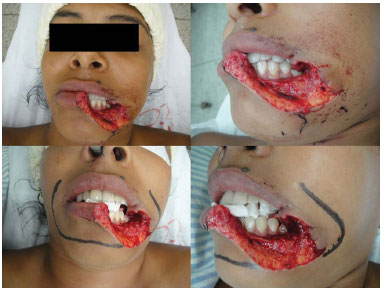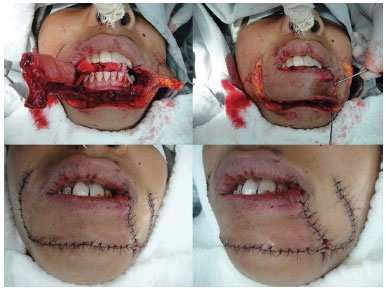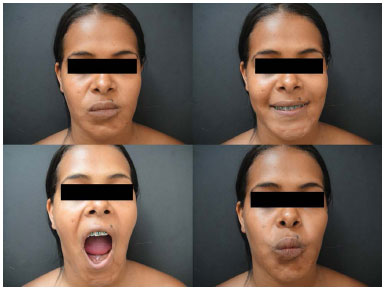

Case Report - Year 2015 - Volume 30 - Issue 4
The use of the Karapandzic flap for reconstruction of the lower lip after trauma
Utilização do retalho de Karapandzic para reconstrução de lábio inferior após trauma
ABSTRACT
Lip reconstruction is a challenge to the plastic surgeon. The lips are the dynamic center of the lower third of the face, being essential for facial movements and expression, speech, deglutition, suction, and containment of salivary secretions, as well as esthetic appearance. Therefore, the objective of lip reconstruction should be functional recovery of the damaged structure and a good esthetic result. This article reports a case of severe traumatic labial injury and reconstruction, using the Karapandzic flap. The authors demonstrate its functionality and easy implementation as well as the final result.
Keywords: Lip; Lip/surgery; Lip/injuries; Surgical Flaps; Reconstructive surgical procedures.
RESUMO
A reconstrução labial representa um desafio ao cirurgião plástico. Os lábios são o centro dinâmico do terço inferior da face, sendo fundamentais para mímica e expressão facial, fala, deglutição, sucção e contenção de secreções salivares, sem esquecer-se do componente estético. Portanto, a reconstrução labial deve ter como objetivo o restabelecimento funcional da estrutura lesada e um bom resultado estético. Este artigo relata um caso de lesão labial traumática grave e sua reconstrução, com a utilização do retalho de Karapandzic. Os autores demonstram sua funcionalidade e fácil execução, assim como seu resultado final.
Palavras-chave: Lábio; Lábio/cirurgia; Lábio/lesões; Retalhos cirúrgicos; Procedimentos cirúrgicos reconstrutivos.
The lips are the dynamic center of the lower third of the face. They play a fundamental role in facial expression, articulation of speech, deglutition, and containment of salivary secretions. From an esthetic point of view, the lips have a large impact on one's image, self-esteem, and quality of life1,2.
Anatomically, the lips are composed of three layers: the external skin surface, internal mucosal layer, and the sphincteric structure comprised of the orbicularis oris muscle1,3-6. The latter is responsible for the functions of the oral sphincter, oral continence, speech articulation, facial expression, and access to the oral cavity for hygiene and feeding4.
Thus, lip reconstruction should aim primarily for functional recovery of the damaged area, but a good esthetic result is useless if there is functional disability. Therefore, all efforts should be directed to reconstruct the orbicularis oris sphincter when it is damaged1.
For these reasons, lip reconstruction is a challenge to the surgeon3.
CASE REPORT
A 19-year-old female presented to the emergency plastic surgery service of the Hospital de Base de São José do Rio Preto following a physical assault, with a human bite of the lower lip. She presented with injuries extending from the midline to the left labial commissure laterally, and mentum and sulcus inferiorly, involving more than 50% of the lower lip (Figure 1).

Figure 1. Extent of the lesion and marking of the flap.
She was immediately taken to surgery, and a thorough cleaning of the injury was performed, with debridement and revitalization of the borders. A Karapandzic flap was constructed, with total repair of the orbicularis oris muscle, skin, and mucosa, and preservation of the neurovascular branch of the flap (Figure 2).

Figure 2. Release of flaps with preservation of the neurovascular bundle. The entire orbicularis oris muscle is taken with the flap.
Seven days of antibiotic therapy was instituted and tetanus vaccine was administered. The patient was instructed to maintain a liquid-soft diet for 15 days in the postoperative period, and was referred for follow-up with physical therapy, in order to recover maximum oral opening.
The patient made good progress, with preservation of all facial movement and labial sensitivity, and no functional deficit. She maintained the oral opening amplitude (Figure 3).

Figure 3. Postoperatively, 1 year. Note the preservation of facial movements and good oral opening.
DISCUSSION
As mentioned, lip reconstruction aims to recover the functional aspect, with maintenance of the sphincteric component, while maximally preserving sensitivity and oral opening with satisfactory esthetic results.
In order to achieve good reconstruction results, the following principles must be adhered to5:
Several techniques have been described for lip reconstruction6, from primary suture to more complex flaps. The choice of method should take into account the extent of the lesion, the functional recovery, and the condition of the patient.Prioritize function over esthetics Use local tissue as the first option Reconstitute all damaged layers Respect the esthetic units
In cases of major full thickness defects (30% to 80%), primary suture becomes impossible, and local flaps are required3,5.
Gillies and Millard7 described a fan flap for reconstruction of the lower lip. Based on the upper labial artery, it was prepared by rotation and nasolabial advancement toward the midline. However, it may result in microstomy and does not aim to preserve the neurovascular bundle, resulting in a static reconstruction with loss of sensitivity5.
In 1974, Karapandzic4 described a modification of the Gillies fan flap, presenting a more conservative technique, carefully dissecting and preserving nerves and the labial artery. It is performed with semicircular incisions, extending from the inferior margins of the lesion to the nasal wings. Skin and subcutaneous tissue is incised with isolation of the orbicular oris muscle. The mucosa is incised as required. The neurovascular bundle is carefully isolated and preserved and the two margins of the flap are joined, with suture of the edges of the orbicularis oris muscle, skin, and mucosa, respecting the esthetic units (Figures 1 and 2).
The advantage is a functional reconstruction, with preservation of facial movements and sensitivity in the labial region. On the other hand, it may result in microstomy, mainly when the defect is larger. However, this usually responds well to conservative treatment, physical therapy, and dilation. Severe cases may require additional commissuroplasty1,3-5.
CONCLUSION
The Karapandzic flap remains an optimal choice for reconstruction of lip defects. This is one of the most conservative techniques, as its objective is to preserve the neurovascular bundles of the flap, thus preserving sensitivity and facial movements.
REFERENCES
1. Neligan PC. Strategies in lip reconstruction. Clin Plast Surg. 2009;36(3):477-85. PMID: 19505615 DOI: http://dx.doi.org/10.1016/j.cps.2009.02.013
2. Rocha FP, Almeida MWR, Fagundes DJ, Costa TV, Pires JA. Reconstrução de lábio inferior pós-mordedura equina: descrição de técnica e revisão anatômica. Rev Bras Cir Plást. 2010;25(4):719-22. DOI: http://dx.doi.org/10.1590/S1983-51752010000400028
3. Baumann D, Robb G. Lip reconstruction. Semin Plast Surg. 2008;22(4):269-80. DOI: http://dx.doi.org/10.1055/s-0028-1095886
4. Karapandzic M. Reconstruction of the lip defects by local arterial flaps. Brit J Plast Surg. 1974;27(1):93-7. PMID: 4593704 DOI: http://dx.doi.org/10.1016/0007-1226(74)90068-X
5. Kogut J, Sbalchiero JC, Leal PR. Reconstrução labial. In: Melega JM. Cirurgia plástica fundamentos e arte: cirurgia reparadora de cabeça e pescoço. Rio de Janeiro: Medsi; 2003. p.930-48.
6. Araujo Netto BC, Duarte IS, Ferreira LM, Abrahão M. Reconstrução total do lábio inferior com retalhos da face. Rev Bras Cir Plást. 2003;18(1):9-24.
7. Gillies H, Millard Jr. DR, eds. The Principles and art of plastic surgery. Boston: Little Brown; 1959.
Faculdade de Medicina de São José do Rio Preto, São José do Rio Preto, SP, Brazil
Institution: Faculdade de Medicina de São José do Rio Preto, Hospital de Base. São José do Rio Preto, SP, Brazil.
Corresponding author:
João Augusto Martins Guimarães
Av. Anísio Haddad, 8205, Jardim das Palmeiras
São José do Rio Preto, SP, Brazil Zip Code 15091-745
E-mail: jamguimaraes@hotmail.com
Article received: June 17, 2012.
Article accepted: March 10, 2013.


 Read in Portuguese
Read in Portuguese
 Read in English
Read in English
 PDF PT
PDF PT
 Print
Print
 Send this article by email
Send this article by email
 How to Cite
How to Cite
 Mendeley
Mendeley
 Pocket
Pocket
 Twitter
Twitter